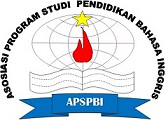INTERACTIVE PATHWAYS: EXPLORING STUDENTS’ ACCEPTANCE OF USING NEARPOD FOR ENGLISH GRAMMAR PROFICIENCY
Abstract
Keywords
References
Abdullah, A., Yahaya, M. F., & Mat Isa, N. (2019). The Impact of Nearpod Interactive Learning Platform in Quality Accounting Education for Sustainable Developmentent. SSRN Electronic Journal. https://doi.org/10.2139/ssrn.3563907
Abykanova, B., Nugumanova, S., Yelezhanova, S., Kabylkhamit, Z., & Sabirova, Z. (2016). The use of interactive learning technology in institutions of higher learning. International Journal of Environmental and Science Education, 11(18), 12528–12539.
Adriani, Y., & Asyifa, C. (2022). The use of technological devices: A descriptive study of students in university. 2022 International Conference on Science and Technology (ICOSTECH).
Ahmad, A. (2020). Exploring DigitalWays for Teaching Basic English Grammar of EFL (English for Foreign Language) Context: An Experience of Indonesian Students. ICoSEEH 2019, 233–237. https://doi.org/10.5220/0009105402330237
Alfadda, H. A., & Mahdi, H. S. (2021). Measuring Students’ Use of Zoom Application in Language Course Based on the Technology Acceptance Model (TAM). Journal of Psycholinguistic Research, 50(4), 883–900. https://doi.org/10.1007/s10936-020-09752-1
Alharbi, M. (2015). Effects of Blackboard’s discussion boards, blogs and wikis on effective integration and development of literacy skills in EFL students. English Language Teaching, 8(6), 111–132. https://doi.org/10.5539/elt.v8n6p111
Andriani, A., Yuniar, V. D., & Abdullah, F. (2021). Teaching English Grammar in an Indonesian Junior High School. AL-Ishlah: Jurnal Pendidikan, 13(2), 1046–1056. https://doi.org/10.35445/alishlah.v13i2.956
Anggoro, K. J., Khasanah, U., & Milnes, N. (2022). Nearpod Slides to Enhance Students’ Self-Study. Studies in Self-Access Learning Journal, 13(4).
Arndt, H. L., & Woore, R. (2018). Vocabulary learning from watching YouTube videos and reading blog posts. Language Learning and Technology, 22(3), 124–142.
Boddy, C. R. (2016). Sample size for qualitative research. Qualitative Market Research: An International Journal, 19(4), 426–432. https://doi.org/10.1108/QMR-06-2016-0053
Burton, R. (2019). A review of Nearpod – an interactive tool for student engagement. Journal of Applied Learning & Teaching, 2(2), 95–97. https://doi.org/10.37074/jalt.2019.2.2.13
Creswell, J. W., & Plano Clark, V. L. (2017). Designing and conducting mixed methods research (3rd ed). Sage Publications.
Davis, F. D. (1989). Perceived usefulness, perceived ease of use, and user acceptance of information technology. MIS Quarterly: Management Information Systems, 13(3), 319–339. https://doi.org/10.2307/249008
Fattah, S. F. E. S. A. (2015). The Effectiveness of Using WhatsApp Messenger as One of Mobile Learning Techniques to Develop Students’ Writing Skills. Journal of Education and Practice, 6(32), 115–127. http://libezproxy.open.ac.uk/login?url=http://search.ebscohost.com/login.aspx?direct=true&db=eric&AN=EJ1083503&site=ehost-live&scope=site
Hakami, M. (2020). Using Nearpod as a Tool to Promote Active Learning in Higher Education in a BYOD Learning Environment. Journal of Education and Learning, 9(1), 119. https://doi.org/10.5539/jel.v9n1p119
Hornsby, D. J., & Osman, R. (2014). Massification in higher education: Large classes and student learning. Higher Education, 67(6), 711–719. https://doi.org/10.1007/s10734-014-9733-1
Hwang, G.-J., Lai, C.-L., & Wang, S.-Y. (2015). Seamless flipped learning: a mobile technology-enhanced flipped classroom with effective learning strategies. Journal of Computers in Education, 2(4), 449–473. https://doi.org/10.1007/s40692-015-0043-0
Jing, T. W., & Yue, W. S. (2016). Real-Time Assessment with Nearpod in the BYOD Classroom. Taylor’s 8th Teaching and Learning Conference 2015 Proceedings, 103–107.
Keržič, D., Tomaževič, N., Aristovnik, A., & Umek, L. (2019). Exploring critical factors of the perceived usefulness of blended learning for higher education students. PloS One, 14(11), e0223767.
Lemeshchenko-Lagoda, V., Kryvonos, I., & Kolodii, O. (2020). Integration of information and communication technologies into the process of learning the course of English for specific purposes as one of the requirements for sustainable future development. E3S Web of Conferences, 166, 10005. https://doi.org/10.1051/e3sconf/202016610005
Lestari, P., & Sihombing, L. H. (2022). Exploring a digital tool “Nearpod” to improve students’ skill in writing. Edupedia, 6(2), 73–79. http://studentjournal.umpo.ac.id/index.php/edupedia
Peng, H. (2021). Applying Nearpod to 10 th -Grade History Courses to Improve Teaching Efficiency. https://doi.org/10.2991/assehr.k.211220.462
Pupah, E. M., & Sholihah, U. (2022). Enhancing EFL students’ reading learning process in COVID-19 pandemic through Nearpod. Englisia: Journal of Language, Education, and Humanities, 9(2), 17. https://doi.org/10.22373/ej.v9i2.10400
Putra, A. P., Arafik, M., & Pratiwi, I. (2021). Use of Nearpod to Enhance Student Engagement in Online Learning. 2021 7th International Conference on Education and Technology (ICET), 298–303. https://doi.org/10.1109/ICET53279.2021.9575062
Ridwan, N. A., & Mahliatussikah, H. (2021). Al-Arabi: Journal of Teaching Arabic as a Foreign Language Using Nearpod for Teaching Arabic in Kindergarten and Madrasah Ibtidaiyah ا ستخدام نيربود لتعليم اللغة العربية في روضة األطفال و امل درسة ال بتدائية. Al-Arabi: Journal of Teaching Arabic as a Foreign Language, 5(2), 142–155. http://dx.doi.org/10.17977/um056v5i2p142-155
Rios-Zaruma, J., Chamba-Rueda, L., Zumba-Zuniga, M. F., & Pardo-Cueva, M. (2019). Application of ICT and M-Learning to Improve Collaborative Learning and Interaction Using the Nearpod Platform. 2019 14th Iberian Conference on Information Systems and Technologies (CISTI), 1–6. https://doi.org/10.23919/CISTI.2019.8760728
Ryan, B. J. (2017). Near Peers: Harnessing the power of the populous to enhance the learning environment. Irish Journal of Technology Enhanced Learning, 2(1). https://doi.org/10.22554/ijtel.v2i1.16
Shehata, N., Mitry, C., Shawki, M., & El-Helaly, M. (2020). Incorporating Nearpod in undergraduate financial accounting classes in Egypt. Accounting Education, 29(2), 137–152.
Syathroh, I. L., Kareviati, E., Lestari, A., & Fitria, N. (2021). EXPLORING THE POTENTIALS OF TECHNOLOGY INTEGRATION FOR TEACHING LANGUAGE SKILLS: A LITERATURE REVIEW. PROJECT (Professional Journal of English Education), 4(3), 488. https://doi.org/10.22460/project.v4i3.p488-496
Tanjung, F. Z. (2018). Language Learning Strategies in English As a Foreign Language Classroom in Indonesian Higher Education Context. LLT Journal: A Journal on Language and Language Teaching, 21(Suppl), 50–68. https://doi.org/10.24071/llt.v21isuppl.966
Turahmah, A., Djunaidi, D., & Jaya, A. (2023). Nearpod Website Strategy in Increasing Studentsâ€TM Listening Ability. Esteem: Journal of English Study Programme, 6(1), 95. https://jurnal.univpgri-palembang.ac.id/index.php/esteem/article/view/10220
Wang, J., & Chia, I. (2022). Engaging Students via Nearpod ® in Synchronous Online Teaching. Management Teaching Review, 7(3), 245–253. https://doi.org/10.1177/2379298120974959
Weng, F., Yang, R. J., Ho, H. J., & Su, H. M. (2018). A tam-based study of the attitude towards use intention of multimedia among school teachers. Applied System Innovation, 1(3), 1–9. https://doi.org/10.3390/asi1030036
Xian, J. (2021). A Critical Evaluation of Nearpod’s Usefulness in Teaching K-12 Biology Science Online Classroom. https://doi.org/10.2991/assehr.k.211220.156
Zaki, A. S., & Ahmad, A. (2017). The Level of Integration among Students at Secondary School: A Study in Limbang, Sarawak. The International Journal of Social Sciences and Humanities Invention, 4(2), 3284–3288. https://doi.org/10.18535/ijsshi/v4i2.05
DOI: http://dx.doi.org/10.20527/jetall.v7i1.17579
Refbacks
- There are currently no refbacks.
This journal is indexed in:


This Journal is listed in:
 Journal of English Teaching, Applied Linguistics and Literatures (JETALL)
Journal of English Teaching, Applied Linguistics and Literatures (JETALL)








.png)



1.png)
